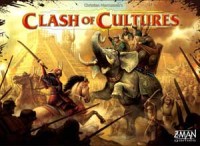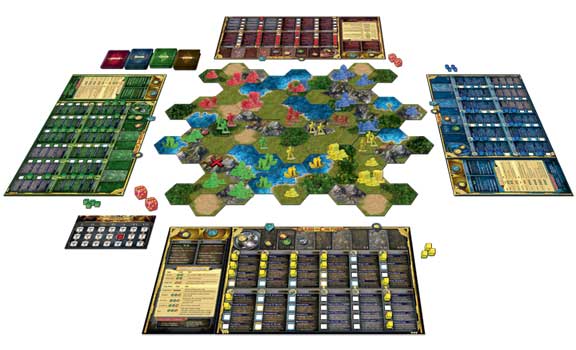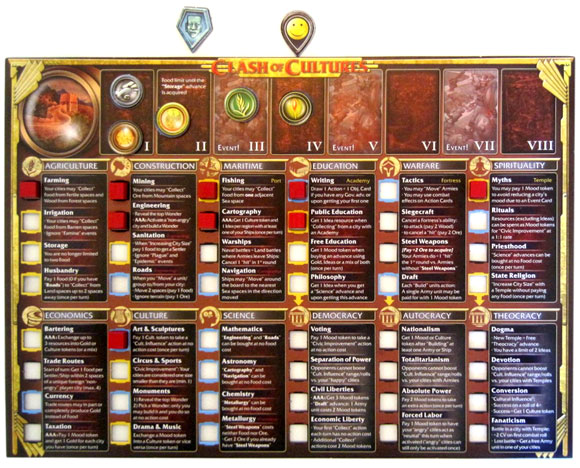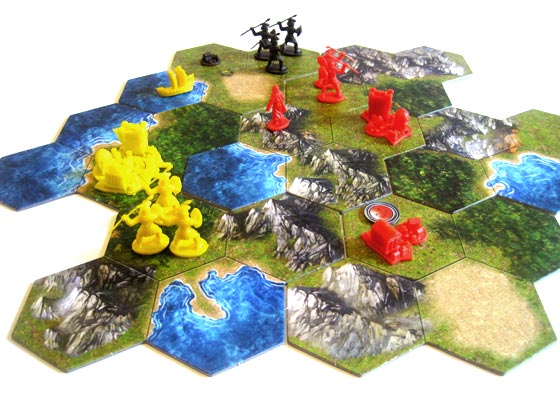
Clash of Cultures
Overview
In Clash of Cultures, each player guides the cultural advancement of his civilization; beginning the game with one small settlement and one settler. With each turn, players must advance their cultures by gathering resources, expanding outward and growing their cities. Choosing specific advancements in military, arts, sciences and spirituality increase your chance of survival – especially when the barbarians attack and catastrophic events occur. Players will strive to meet objectives, build wonders, use their armies to defend against attacks and build ships to promote trade. The player who has the most victory points after six rounds of play has succeeded in having their culture thrive. Like life itself, no two cultures will ever be the same!

Set Up
The game sets up differently for two, three and four player games. Based on the number of players a specific region tile configuration is used. The region tiles are laid out face down and the players each begin the game at a specific face up region. On that region (on the fertile space) the player places one settlement and one settler piece. Players also take a player board, a player aid, and all the cubes, city pieces and units of one their chosen player color.
At the top of the player board is a “scale” numbered from roman numeral I to VIII. On the “0” space to the left, a happiness and culture token is placed as well as one token representing each resource in the game: wood, food, ore, ideas and gold. The player board also lists the possible cultural “Advances” a player can acquire throughout the game. Each player begins with Farming and Mining. All the decks of cards are shuffled (Objective, Action, Event and Wonder) and one Objective and Action are dealt to each player. The turn marker is placed on the first space of the turn track, and players roll to see who goes first. (Whew!) Building a culture is tough work! So let’s get too it!
Gameplay
Note: The gameplay of Clash of Cultures has many options and nuances, (imagine building your own culture from the ground up!) So, to maintain clarity, the gameplay is simplified below, focusing on the main mechanics and leaving out some of the details that make the game a deep and rewarding experience. To learn more, the full rulebook is posted here. Enjoy!
Clash of Cultures is won with victory points which are gained mainly by building City pieces, and having Cultural Advances. You also gain points by completing objectives and building Wonders.
The game is played in a series of six rounds. Each round consists of three player turns. At the end of each round is a Status phase where cool things happen to the world and to players themselves.
On each turn you have six actions you can take. Advance, Found a City, Activate a City, Move Units, Civic Improvement and Cultural Influence. Here are the actions in more detail:
Advance
Pay three Food to add a cube to your player board on the advancement of your choice. Whoa, wait a minute!! Look at all those Advances! What advance do you choose? Well that’s the whole challenge of building a culture!

Advances on the player board are broken down into major categories (see above image.) How you develop your culture is based on these categories and the special game effects they create. You must choose the first, or topmost Advance in each category first but then you can choose any Advance in that category. And for four of the Advances, (Maritime, Education, Warfare and Spirituality) you must have this advance to build that specific structure (listed in yellow next to their heading). Notice how there are yellow and blue outlines around some of the boxes? If you choose one of these Advances your blue (Culture) token, or Yellow (Happiness) token moves up the track at the top of the player board. If it lands on a space that says “Event,” draw an Event card and resolve it. Events can hurt a bit, but let’s leave those to the imagination for now.
Some Advances help you get other Advances. Some help in movement, warfare, ship building…you name it.
Found a City
This is easy. If you have a Settler unit on a space where there are no foreign cities or units, replace your settler with a Settlement piece. Boom! You have a new city. Cities can do all sorts of cool things. Read on…
Activate a City
Cities are where the action is. Well three specific actions, actually. When you activate a city you can Increase your City’s Size, Collect Resources or Build Units.

Increasing Your City’s Size: This requires you to pay one Food, one Ore and one Wood. You can then attach a new City Piece (Fortress, Academy, Temple or Port) to your starting settlement. See how the pieces fit together? You can choose whichever city piece you want; each has it’s own benefit for game play. So a city with a Temple and a Settlement is size 2.
Collecting Resources: You need Resources to do everything in the game. Each space except barren land produces a resource: Food from fertile lands, Wood from forests and so on. Collect one resource from a different space based on the size of your city. So a size 2 city could get 2 resources from the hexes on or adjacent to their city. Just move the resource marker up on the scale at the top of the player board.
Building Units: You can choose to Build Units when you activate a city as well. You can build a number of units based on the size of your city. A Settler costs 2 Food, an Army Unit costs 1 Food and 1 Ore and a Ship costs 2 Wood. You place them in your city or at your port.
Move Units
Use an action to move one or a group of up to three Units one hex. Moving onto an unexplored region tile allows you to flip it and place your unit on a specific space of that region. If you land on an enemy hex there will be a battle!
Battles are innovative. You roll one d6 for each unit attacking or defending. Other bonuses may apply based on advancements and such. Players roll and divide the total result by 5. The higher CV (Combat Value) wins and the difference is the number of hits taken by the opposing force. Players remove one Unit per “hit” taken. If any units remain, then another round of Battle ensues until one force is destroyed, or the battle ceases voluntarily.

Civic Improvement
In Clash of Cultures cities have moods. They can be Happy, Neutral or Angry depending on how you treat them. All Cities start feeling Neutral. But if they are attacked or you use them twice in the same turn, they can get Angry. Civic Improvement means simply moving them up one step on the scale from Angry to Happy. Happy cities gets a bonus to their size, increasing your ability to produce units, collect resources and so on. Angry Cities are considered size 1, no matter how many city pieces you have.
Cultural Influence
You can attack other players’ cities OR you can influence them with your awesome culture. Just target an opponent’s city 2 spaces away and roll a die. On a 5 or a 6, you may replace one of their City pieces with the same piece of your player color. You opponent doesn’t lose the piece, in fact they still get to use its abilities, but it now is under your cultural influence and will score YOU points at the end of the game.
So after each player takes 3 actions, 3 times, the round ends with a Status Phase. Here things get interesting! There are five steps to the Status Phase (nothing too complicated). Each player checks to see if they have completed any Objective cards. If so they score them. Then each player gets one free Advance of his or her choice. Players then draw one new Objective and Action card. Next, if a player chooses, they can raze (destroy) one of their Settlements and gain one Gold resource. Finally, totaling each player’s Cultural advancement and their Happiness total from their player board determines the first player. Highest total goes first.

The winner of Clash of Cultures is determined after 6 rounds by totaling victory points (VP). You get 1 VP for each City piece in your color. 1/2 a VP for each Advance you have. 2 VP for each Objective and 5 VP for building a “Wonder.” The player with the most points wins!
There is so much more to the gameplay that develops as each turn takes place. But in essence, each player’s culture will begin to encroach on other cultures. Conflict will arise, very distinct match-ups will occur as each player vies for their culture to be the most prominent. There are also the Barbarians – a sort of in -game adversary for all players that can really wipe you out. Barbarians don’t like culture it seems. So when events occur, they can spawn and attack!
Components
The sheer quantity of components in the game makes this game a feast for the eyes. The graphic artwork, the unique city pieces that puzzle together, the tokens, cards, units, player aid, turn tracker and especially the player boards where cubes fit nicely into small indentations – all of these work together in great synergy to provide an easy-to-follow game sequence. The Wonders cardboard stand-ups look a bit out of place, but are functional. The game also has one of the best box cover illustrations of any game on any shelf. More on this in “Final Thoughts.”
Learning Curve
High. Clash of Cultures does take a few turns to get the hang of. With so much going on, folks who are used to lighting quick game turns and fast under-an-hour games will find it rewarding if a bit of patience is applied. Even after several games more complex strategies will manifest themselves. Mastering the game will take some time. So grab a chair and get comfortable.
Who would enjoy this game?
Final Thoughts
Many civ-building games go unplayed and unexplored by casual or family gamers simply because of their complexity and length. The iconic civ-building games are often reserved for Strategy or Power gamers.
Enter Clash of Cultures! This IS a unique civ-building game and a perfect gateway game for those that may be less familiar or slightly intimidated by the time and commitment needed for the more expansive civ-builders. Why is it a great gateway game?
It’s accessible. The game lasts 6 rounds (4 for a shorter version) as opposed to a lengthy time period or point based victory condition. The game turns offer choices but not so many that you are bogged down in analysis paralysis. The game turns are simple, clear and concise and very balanced.
It’s not about time. Civ-building games often follow a preset time frame based on historical ages (ie: Stone age… bronze age… and so forth). Not so here. Not being locked into a historical time track offers a freeing experience while your culture grows. The game is non-time specific, and offers a unique thematic background.
Variable game end. The game offers several game-end options, one of which ends the game randomly. The turn track has a reverse side that goes up to 7 rounds instead of 6. During the Status Phase, a die roll determines if the game ends there and then. This keeps players from initiating all-or-nothing end game strategies which, in turn, increases replay value.
Player interaction. Just a small paragraph on page 14 of the rules, but a huge aspect of any civ-building game is deal-making. Players have common threats with the Event cards and Barbarians so trading can be a culture-saver! You can trade just about anything – even mood tokens. (Pay me 3 gold and I’ll make your city happy!) What!?
Combat is unique. The system for totaling Combat Value is unique in that every pip on every die rolled is used. Instead of employing a target number system: (i.e. roll over a 3 to hit). All the pips are totaled on all the dice and are divided by 5. This makes every die and every pip crucial. You very rarely ever roll and miss. It’s streamlined and innovative.
Most importantly, it’s not culture specific. No you aren’t the ancient Egyptians, Feudal Japan, Aztecs or the Persians. You are NOT limited to these specific cultures. The genius of this game is that you can develop your culture to emulate ANY of these cultures – or a unique mix of any of them. Explore religion, science, military, nautical advances. You create your own culture to act and react to other players’ gameplay, which sets this game apart.
Clash of Cultures does not stand as equal with other civ-building games, it stands apart. If you are a casual, avid or family gamer, and are looking for a medium strategic game or a doorway into a more in-depth game experience that will challenge you to nurture your own unique culture into existence, look no further. The game is well balanced with components that are solid and striking. Most importantly, Christian Marcussan offers some distinctive mechanics that will leave you wanting to play again and again.
Elephants?
Finally…elephants. It is difficult to ignore the number of comments made regarding the fact that the box cover art (remarkably rendered by artist Chris Quilliams) depicts Persian war elephants in battle and yet no elephants appear in the game. This is a truly unfortunate and uninformed observation. The box cover imagery is perfect for this game. Why? Artist Chris Quilliams describes the development of the box art in this way:

“This cover went through many stages and it was decided that the idea of elephants and Persian-like culture and Japanese Samurai on horses were a nice visual contrast of imagery. The cover was based on an idea that different cultures from different time periods are represented. On the back of the box you’ll see a Viking-like culture standing amongst Egyptian like pyramids another clash of imagery representing this idea.”
The box cover depicts Persians from the 4th century fighting Samurai from the 13th century. So you see, Clash of Cultures is culturally ambiguous to provide the most expansive play experience without being limited by historical figures or actual cultures.
Could your culture be like the Persians, The Samurai, the Babylonians, Egyptians, or a hundred other cultures? Yup. In this remarkable game, it is about building YOUR unique culture, not trying to duplicate history. If this sort of distinctive game experience appeals to you, then dive into Clash of Cultures. You will find it rewarding again and again.
User Reviews (0)
Add a Review for "Clash of Cultures"
You must be logged in to add a review.


Be the First to Add a Review!